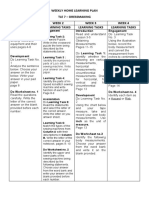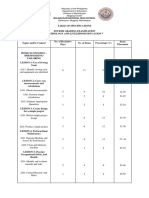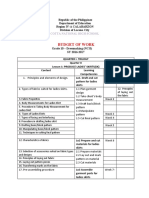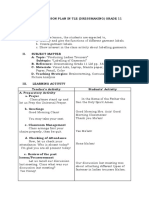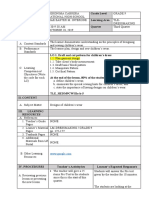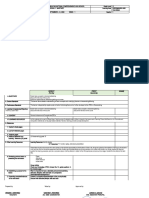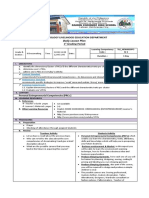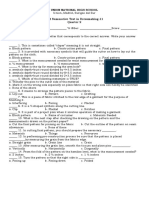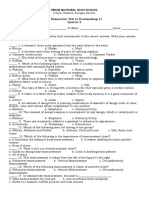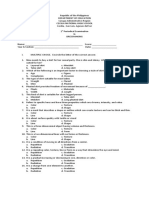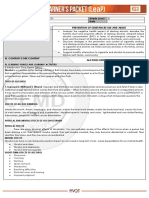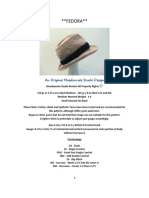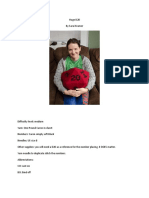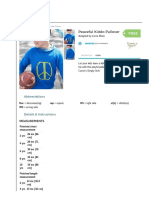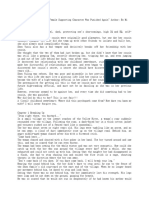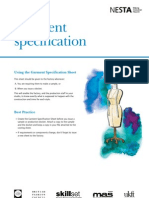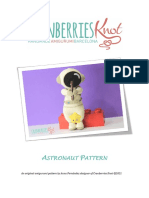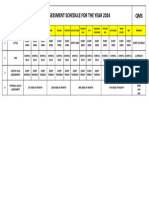LE Comon Machine Troubles
LE Comon Machine Troubles
Uploaded by
Catherine Joy De ChavezCopyright:
Available Formats
LE Comon Machine Troubles
LE Comon Machine Troubles
Uploaded by
Catherine Joy De ChavezCopyright
Available Formats
Share this document
Did you find this document useful?
Is this content inappropriate?
Copyright:
Available Formats
LE Comon Machine Troubles
LE Comon Machine Troubles
Uploaded by
Catherine Joy De ChavezCopyright:
Available Formats
Republic of the Philippines
Department of Education
Region IV-A CALABARZON
SCHOOLS DIVISION OF BATANGAS CITY
Learning Area TLE - Home Economics -Dressmaking
Learning Delivery Modality Digital Modular Distance Modality
School Batangas NHS Grade Level 8
Teacher Marites C. Manalo Learning Area Home Economics- Dressmaking
Teaching Date September 24 - 25, 2020 Quarter FIRST
Lesson Teaching Time 60mins/meeting No. of Days 2
Exemplar
I. OBJECTIVES At the end of the lesson, the learners are expected to:
a. Identify the common sewing machine troubles.
b. Discuss the causes and remedies of the common sewing machine
troubles.
c. Appreciate the value of resolving the common sewing machine
troubles.
B. Content The learner demonstrates understanding in performing basic maintenance of sewing
Standards machine in dressmaking/ tailoring.
C. Performance The learner consistently performs basic maintenance of sewing machine in dressmaking/
Standards tailoring.
D. Most Essential 3. Clean and lubricate machine
Learning 3.2 . Resolve common machine troubles.
Competencies
(MELC)
E. Enabling
Competencies
(If available, write
the attached
enabling
competencies)
II. CONTENT
The common sewing machine troubles
III.
A. References
a. Teacher’s PIVOT BOW p. 283
Guide CG p. 6 TLE_HEDM7/8BM-0h-b-6
b. Learner’s K to 12 Basic Education Curriculum Technology and Livelihood Education Learning
Materials Module Dressmaking/Tailoring G7/G8 pp. 82 - 84
Pages
c. Textbook
Pages
B. List of Learning Video presentation
Resources for Common Sewing Machine Troubles
Development and https://www.youtube.com/watch?v=ecdzrh0wTFo
Engagement https://www.youtube.com/watch?v=4rdWWAsTgro
Accelerate Learners Achievement with Excellence and Humility
Address: P. Herrera St., Batangas City
Telephone No. (043) 702-2094
Email: division.batangascity@deped.gov.ph
DEPEDBATC-SDO-F-009/R1/02-20-2020
Republic of the Philippines
Department of Education
Region IV-A CALABARZON
SCHOOLS DIVISION OF BATANGAS CITY
Activities https://www.youtube.com/watch?v=kQ7wp8PcR08
Worksheets
Information Sheet
IV. PROCEDURES
Introduction PICTIONARY
Directions: Write your answer on a sheet of paper.
Iches
t
loop s
A B
Which picture you like most? Why? What is the message of the pictures?
VISUAL SEARCH
S
e
a machine runs noisily
m
needle breaks
fab
ric
m
ja
p
machine rotates heavily
u
c
k
thread breaks
e
r Fabric does not move
Are you familiar with these words? How will you classify these words? Going back
to our Pictionary what emotion will you have if you are working with these words? Is it
A or B? Why? How can you have A if you chose B? and vice versa. Ask anyone in your
house if they experienced these common machine troubles. How did they respond to
these problems? Write your answer in your activity notebook.
Development Watch Me
Accelerate Learners Achievement with Excellence and Humility
Address: P. Herrera St., Batangas City
Telephone No. (043) 702-2094
Email: division.batangascity@deped.gov.ph
DEPEDBATC-SDO-F-009/R1/02-20-2020
Republic of the Philippines
Department of Education
Region IV-A CALABARZON
SCHOOLS DIVISION OF BATANGAS CITY
Video viewing of these links
https://www.youtube.com/watch?v=ecdzrh0wTFo
https://www.youtube.com/watch?v=4rdWWAsTgro
https://www.youtube.com/watch?v=kQ7wp8PcR08
Guide questions:
1. What are the common machine troubles?
2. What are the causes of these troubles?
3. How will you resolve them?
Read Me
Read Information Sheet 3.2. and do Activity Sheet 3.2.
Engagement THINK OF IT
Directions: Identify the common sewing machine troubles shown. Tell the causes and
the remedies. Use the provided worksheet .
TROUBLES CAUSES REMEDIES
1.
2.
Accelerate Learners Achievement with Excellence and Humility
Address: P. Herrera St., Batangas City
Telephone No. (043) 702-2094
Email: division.batangascity@deped.gov.ph
DEPEDBATC-SDO-F-009/R1/02-20-2020
Republic of the Philippines
Department of Education
Region IV-A CALABARZON
SCHOOLS DIVISION OF BATANGAS CITY
3.
4.
5.
STORY TELLING
Directions: Make a story featuring these pictures. The content evolves on the common
sewing machine troubles, its remedies and appreciation of resolving these troubles. You
can use 300 important words excluding the articles, conjunctions, coordinators, and
prepositions.
Accelerate Learners Achievement with Excellence and Humility
Address: P. Herrera St., Batangas City
Telephone No. (043) 702-2094
Email: division.batangascity@deped.gov.ph
DEPEDBATC-SDO-F-009/R1/02-20-2020
Republic of the Philippines
Department of Education
Region IV-A CALABARZON
SCHOOLS DIVISION OF BATANGAS CITY
Criteria:
Organization of Ideas and concepts: 40 pts.
Fresh Point of View: 20 pts.
Creativity: 30 pts.
Word limit: 10 pts.
TOTAL: 100 pts.
B. Assimilation CASE STUDY
Use three (3) among the ten (10) common sewing machine troubles. Make a case
study of them. Once you have gathered the necessary information, a draft of your
analysis should include these sections:
1. Introduction:
Identify the key problems and issues in the case study.
2. Background:
Set the scene (where it happened), background information (why it happened),
relevant facts (the problem) and the most important issues (how to solve the
problem).
3. Alternatives:
Include other solutions to the problem gathered from the other sources (could
be your family members’ advice), if they are rejected, state the reasons of
rejections or why it/these are not possible at this time.
4. Proposed Solution:
Provide one specific and realistic solution. Explain why this solution was
chosen
Support this solution with a solid evidence.
5. Recommendation:
Accelerate Learners Achievement with Excellence and Humility
Address: P. Herrera St., Batangas City
Telephone No. (043) 702-2094
Email: division.batangascity@deped.gov.ph
DEPEDBATC-SDO-F-009/R1/02-20-2020
Republic of the Philippines
Department of Education
Region IV-A CALABARZON
SCHOOLS DIVISION OF BATANGAS CITY
Recommend further action to resolve the some of the issues.
What should be done and who should do it?
V. REFLECTION
The learners, in thei ractivity notebook, journal or portfolio will write down their
personal insights about the lesson using the prompts below.
I understand that ________________________
I realized that ____________________________
Accelerate Learners Achievement with Excellence and Humility
Address: P. Herrera St., Batangas City
Telephone No. (043) 702-2094
Email: division.batangascity@deped.gov.ph
DEPEDBATC-SDO-F-009/R1/02-20-2020
You might also like
- Fairy Night Light TotalDocument7 pagesFairy Night Light Totalmonicamauder100% (3)
- Rose Ntal Sweater PatternDocument16 pagesRose Ntal Sweater PatternThanh Thảo Nguyễn100% (3)
- Singer Sewing Machine Model 237: The Singer "Fashionmate"Document66 pagesSinger Sewing Machine Model 237: The Singer "Fashionmate"Callie93% (15)
- Quality Control PlanDocument10 pagesQuality Control PlanGAURAV SHARMA100% (1)
- Weekly Home Learning Plan Tle 7 - Dressmaking Week 1 Week 2 Week 3 Week 4 Learning Tasks Learning Tasks Learning Tasks Learning TasksDocument2 pagesWeekly Home Learning Plan Tle 7 - Dressmaking Week 1 Week 2 Week 3 Week 4 Learning Tasks Learning Tasks Learning Tasks Learning TasksJanice CrenciaNo ratings yet
- Mindoro, Marinduqe, and Romblon Folk ArtsDocument6 pagesMindoro, Marinduqe, and Romblon Folk Artshakuna matataNo ratings yet
- Blueberry BodyDocument6 pagesBlueberry BodyMarta Lasala100% (1)
- Week 24 DressmakingDocument3 pagesWeek 24 DressmakingBarbara PosoNo ratings yet
- G9 DLL Q2-LO3 Lesson 1Document7 pagesG9 DLL Q2-LO3 Lesson 1ariezan2023No ratings yet
- 4th Grading TLEDocument4 pages4th Grading TLEBalacan NHS Balanacan NHSNo ratings yet
- 1st-Quarter Diagnostic Test in Dressmaking 2023-2024Document2 pages1st-Quarter Diagnostic Test in Dressmaking 2023-2024Marlene MorgaNo ratings yet
- Tle 9 Nov 25-29Document3 pagesTle 9 Nov 25-29Mariel Lopez - Madrideo100% (1)
- Dressmaking10 - Q2 - W1 - LEDocument5 pagesDressmaking10 - Q2 - W1 - LESonia CanaNo ratings yet
- TLE III For Division Unified TestDocument3 pagesTLE III For Division Unified TestMiraeric Ez BabsNo ratings yet
- 1st QTR Exam in Tle Dressmaking8Document4 pages1st QTR Exam in Tle Dressmaking8FLORAME OÑATE100% (1)
- 1st Periodical Exam in TVL 11 at 12Document6 pages1st Periodical Exam in TVL 11 at 12sally100% (1)
- Budget of Work: Cotta National High SchoolDocument5 pagesBudget of Work: Cotta National High SchoolAngelica B. CatanNo ratings yet
- Technology and Livelihood Education Dressmaking 2 Learning ModuleDocument8 pagesTechnology and Livelihood Education Dressmaking 2 Learning ModuleLui PeletinaNo ratings yet
- BOW Dressmaking JHS 9 10Document2 pagesBOW Dressmaking JHS 9 10Scarlette Beauty EnriquezNo ratings yet
- DETAILED LESSON PLAN IN TLE For COTDocument6 pagesDETAILED LESSON PLAN IN TLE For COTdainee OciteNo ratings yet
- 3rd PT in TLE G8Document3 pages3rd PT in TLE G8Leni May N. LuistroNo ratings yet
- Daily Lesson Log in Tle 10 Dressmaking Quarter 1 Week 1Document8 pagesDaily Lesson Log in Tle 10 Dressmaking Quarter 1 Week 1Cristita RafinianNo ratings yet
- Technology and Livelihood Education: (Dressmaking/Tailoring)Document12 pagesTechnology and Livelihood Education: (Dressmaking/Tailoring)BIT ButuanNo ratings yet
- Detailed Lesson Plan: Date: June 20, 2019Document2 pagesDetailed Lesson Plan: Date: June 20, 2019Linlen Malait ViagedorNo ratings yet
- Weekly Home Learning Plan (WHLP) For Subject Teachers: DAY Time Learning Competency Learning Tasks Mode of DeliveryDocument3 pagesWeekly Home Learning Plan (WHLP) For Subject Teachers: DAY Time Learning Competency Learning Tasks Mode of DeliveryDhom Ortiz Candelaria100% (1)
- TLE Dressmaking9 q1 Mod1.3Document14 pagesTLE Dressmaking9 q1 Mod1.3Carla Marie JavierNo ratings yet
- Tle Dressmaking9 q3 m11Document13 pagesTle Dressmaking9 q3 m11ALLYSSA MAE PELONIANo ratings yet
- 1 DLL Designs of Children S WearDocument6 pages1 DLL Designs of Children S WearcharleneNo ratings yet
- Daily Lesson Log: School District Teacher Grade School Code JUNE 25, 2018 (Monday)Document2 pagesDaily Lesson Log: School District Teacher Grade School Code JUNE 25, 2018 (Monday)Dave Claridad100% (1)
- DLL DRESSMAKING w3Document3 pagesDLL DRESSMAKING w3Virginia Martinez100% (1)
- Dressmaking LP 1Document5 pagesDressmaking LP 1Marielle Andrea CasicasNo ratings yet
- Parts of Sewing MachineDocument5 pagesParts of Sewing MachineArgelyn Magsayo LptNo ratings yet
- Q3-Exam Tailoring 9 With TOSDocument3 pagesQ3-Exam Tailoring 9 With TOSbrigette.arocoNo ratings yet
- Technology Livelihood Education Department 1 Grading Period: Daily Lesson PlanDocument4 pagesTechnology Livelihood Education Department 1 Grading Period: Daily Lesson PlanPhoenixZen100% (1)
- Daily Lesson Log: School District Teacher Grade School Code JUNE 22, 2018 (Friday)Document2 pagesDaily Lesson Log: School District Teacher Grade School Code JUNE 22, 2018 (Friday)Dave ClaridadNo ratings yet
- SECOND PERIODIC EXAM Dressmaking 9 PRINTDocument4 pagesSECOND PERIODIC EXAM Dressmaking 9 PRINTzaldy mendozaNo ratings yet
- DLL Cot2Document2 pagesDLL Cot2MARITA MORALESNo ratings yet
- DLL Day 1 - Feb 20Document4 pagesDLL Day 1 - Feb 20Lyrna Martinez Llander100% (1)
- Strategic Intervention Material: Parts of Sewing MachineDocument23 pagesStrategic Intervention Material: Parts of Sewing Machinejane calloNo ratings yet
- Dressmaking: Cut Final PatternDocument22 pagesDressmaking: Cut Final PatternJully Joy TejanoNo ratings yet
- 2nd Summative-Q2 DressmakingDocument1 page2nd Summative-Q2 DressmakingWendy Arnido0% (1)
- G8 Instructional Plan in DressmakingDocument1 pageG8 Instructional Plan in DressmakingGalvez ChaChaNo ratings yet
- 3rdQ Test TLE9 .1Document4 pages3rdQ Test TLE9 .1Enrick Pestilos100% (1)
- Union National High SchoolDocument3 pagesUnion National High SchoolWendy Arnido100% (1)
- Week 1 Dressmaking 8Document20 pagesWeek 1 Dressmaking 8Lovely JavierNo ratings yet
- Cot DressmakingDocument29 pagesCot DressmakingMistekee Maramag100% (1)
- Tle Dressmaking9 Q2 M17Document10 pagesTle Dressmaking9 Q2 M17ALLYSSA MAE PELONIANo ratings yet
- HE DRESSMAKING GR10 Q1 MODULE-6-for-teacherDocument41 pagesHE DRESSMAKING GR10 Q1 MODULE-6-for-teacherLiezel Jane SimblanteNo ratings yet
- 1st Summative-Q2Document2 pages1st Summative-Q2Wendy Arnido100% (1)
- W1 D3 Handicraft Production Lesson 3 LO1Document5 pagesW1 D3 Handicraft Production Lesson 3 LO1Rochelle CatanNo ratings yet
- DLL 0920Document4 pagesDLL 0920RielaDheeLagramaNo ratings yet
- Summative Assessment Q2 W7Document3 pagesSummative Assessment Q2 W7RosselAlcantara100% (2)
- Daily Lesson Log in TLE 10 DressmakingDocument2 pagesDaily Lesson Log in TLE 10 DressmakingCHRISTINE PAGLINAWAN100% (1)
- Union National High SchoolDocument3 pagesUnion National High SchoolWendy ArnidoNo ratings yet
- Excellent (4 PTS.) Very Satisfactory (3 PTS.) Satisfactory (2 PTS.) Needs Improvement (1 PTS.) No Attempts (0 PT.) Points EarnedDocument1 pageExcellent (4 PTS.) Very Satisfactory (3 PTS.) Satisfactory (2 PTS.) Needs Improvement (1 PTS.) No Attempts (0 PT.) Points EarnedMohammad G. Naga100% (1)
- DressmakingDocument6 pagesDressmakingEvangEline Orpina-MirandaNo ratings yet
- DLL TLE Week3Document6 pagesDLL TLE Week3Jepoy Macasaet100% (1)
- 4th Exam Tle DressmakingDocument2 pages4th Exam Tle DressmakingCashmir Mabaquiao Joquino100% (1)
- Activity Sheet Melcs 2.2 ADocument3 pagesActivity Sheet Melcs 2.2 AGrace Beninsig Duldulao100% (1)
- LAS2 DRESSMAKING 10 Q3. Week 2Document5 pagesLAS2 DRESSMAKING 10 Q3. Week 2Reynold MillondagaNo ratings yet
- LAS Grade 10 DressmakingDocument16 pagesLAS Grade 10 DressmakingRoberto MabulacNo ratings yet
- SUMMATIVE TEST No.2 DRESSMAKING 8 FinalDocument1 pageSUMMATIVE TEST No.2 DRESSMAKING 8 FinalCharles Alfred Dela CruzNo ratings yet
- Q3-4-G8-Lesson-Plan DressmakingDocument4 pagesQ3-4-G8-Lesson-Plan DressmakingRhoda RenomeronNo ratings yet
- ASSESSMENTDocument6 pagesASSESSMENTHannah lou TapispisanNo ratings yet
- Pattern Making - Lesson Plan PDFDocument4 pagesPattern Making - Lesson Plan PDFTina AndoyNo ratings yet
- LE Cleaning and Lubricating The Sewing Machine.Document4 pagesLE Cleaning and Lubricating The Sewing Machine.Catherine Joy De ChavezNo ratings yet
- Q4 HEALTH 8 Week 6Document4 pagesQ4 HEALTH 8 Week 6Catherine Joy De ChavezNo ratings yet
- Q4 - Arts 8-Week 1Document5 pagesQ4 - Arts 8-Week 1Catherine Joy De ChavezNo ratings yet
- TLE CarpentryG7 8Document40 pagesTLE CarpentryG7 8Catherine Joy De ChavezNo ratings yet
- LE Follow The Safety Procedures in Machine CleaningDocument5 pagesLE Follow The Safety Procedures in Machine CleaningCatherine Joy De ChavezNo ratings yet
- LE Cleaning and Lubricating The Sewing Machine.Document4 pagesLE Cleaning and Lubricating The Sewing Machine.Catherine Joy De ChavezNo ratings yet
- 110 Fedora Newborn To Mens XXL 2014 2018Document13 pages110 Fedora Newborn To Mens XXL 2014 2018Alexa Serio100% (1)
- Pixie AngelDocument7 pagesPixie AngelRenata TagliatelleNo ratings yet
- Gingerbread_Blanket_Week_3Document6 pagesGingerbread_Blanket_Week_3L0veCr0chetNo ratings yet
- STTU171 - Product SheetDocument2 pagesSTTU171 - Product Sheetbigmamonth99No ratings yet
- All in One Fish Final Jul22Document4 pagesAll in One Fish Final Jul22Josie MOCONo ratings yet
- Dado 20 CrochetDocument5 pagesDado 20 CrochetAna DarenNo ratings yet
- The Brave Little Tailor RHENZUDocument4 pagesThe Brave Little Tailor RHENZURitchelle Ann GregorioNo ratings yet
- Arts and Crafts of LuzonDocument33 pagesArts and Crafts of LuzonAlfVera RectoNo ratings yet
- Lubricants For Textile MachinesDocument36 pagesLubricants For Textile Machinesyakarim67% (3)
- Viking Tent Frame and Cloth For The Real Viking Project, Level 1Document12 pagesViking Tent Frame and Cloth For The Real Viking Project, Level 1mono1144No ratings yet
- Parachute: BackgroundDocument7 pagesParachute: BackgroundSatish PrajapatiNo ratings yet
- Hexa GridDocument1 pageHexa Gridthea.magerandNo ratings yet
- Безрукавка спицямиDocument5 pagesБезрукавка спицямиІрина БердейNo ratings yet
- DFB1411P XPDocument1 pageDFB1411P XPlpraveenkumar580No ratings yet
- Cak0329 007226MDocument3 pagesCak0329 007226MNacada DacanNo ratings yet
- In The Rebirth Era, The Female Supporting Role Was Dealt With AgainDocument592 pagesIn The Rebirth Era, The Female Supporting Role Was Dealt With Againgordon.jauNo ratings yet
- Forage BagDocument15 pagesForage BagAJ L100% (3)
- F.S.C.a - 1 Unit 1 - Elements of Woven DesignDocument11 pagesF.S.C.a - 1 Unit 1 - Elements of Woven DesignkritiNo ratings yet
- Garment SpecDocument2 pagesGarment SpecMohamed MokhtarNo ratings yet
- Astronaut Eng PatternDocument15 pagesAstronaut Eng PatternSara Johnson100% (4)
- 5865690-Pfaff Classic Style 1525 Sewing Machine ManualDocument56 pages5865690-Pfaff Classic Style 1525 Sewing Machine ManualL0UVENo ratings yet
- Do You Know Your History ?: History of Pineapple Fabric (Piña)Document2 pagesDo You Know Your History ?: History of Pineapple Fabric (Piña)alegnaavlis_49327442No ratings yet
- Qms Assessment Schedule 2024Document1 pageQms Assessment Schedule 2024psivakumar menakamillsNo ratings yet
- Kenmore 158.1791 Sewing Machine Instruction ManualDocument48 pagesKenmore 158.1791 Sewing Machine Instruction ManualiliiexpugnansNo ratings yet




